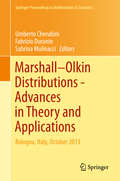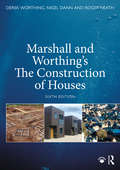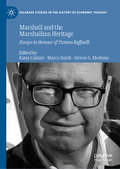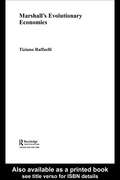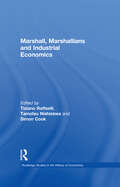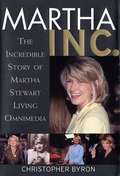- Table View
- List View
Marriott Corp.
by Thomas R. PiperMarriott is considering the repurchase of ten million shares. This is apparently at odds with the financial policies that the Board of Directors passed two years earlier. Students must discuss why the policies were passed and why changes are now necessary. Includes a discussion of debt policy, financing policy and dividend policy. Students also discover stock is currently undervalued.
Marriott Corp. (A)
by Lynn Sharp Paine Charles A. NicholsMarriott Corp.'s chairman and CEO must decide whether to recommend a restructuring of the company to the board of directors. The proposal he is considering would split the Marriott Corp., a premier hotel developer, owner, and manager, into two separate companies by a stock dividend to shareholders. One of the new companies would contain most of Marriott Corp.'s profitable management operations, while the other would retain ownership of its hotel properties as well as most of its long-term debt.
Marriott Corp.: Restructuring
by Steven R. Fenster Roy BurstinDeals with the decision of whether to split Marriott into two companies Marriott International and Host Marriott. Marriott has run into problems owing to the decline in real estate valuation. At the time of the case, it has a significant percentage of assets in hotels it planned to sell. The problem makes it difficult for Marriott to pursue growth strategies. Furthermore, the market price of the company has declined significantly. The reorganization proposed in the case is meant to deal with these problems.
Marriott Corp.: The Cost of Capital
by Richard S. RubackPresents recommendations for hurdle rates of Marriott's divisions to select by discounting appropriate cash flows by the appropriate hurdle rate for each division.
Marriott Corp.: The Cost of Capital (Abridged)
by Richard S. RubackGives students the opportunity to explore how a company uses the Capital Asset Pricing Model (CAPM) to compute the cost of capital for each of its divisions. The use of Weighted Average Cost of Capital (WACC) formula and the mechanics of applying it are stressed.
Marriott International: The Next 90 Years
by Gary P. Pisano Chiara FarronatoThe case examines how Marriott should respond to the potential threats from new home-sharing platforms and the rise of online travel agencies. In 2017 Marriott was the largest hotel chain, with more than one million rooms and 7% of worldwide room supply. In the previous decade the growing ubiquity of internet-based commerce had facilitated the rise of technology platforms such as Expedia and Airbnb. The case enables students to explore the forces that might lead to industry transformation and the appropriate response strategies of a large incumbent.
Marsh & McLennan (A)
by Howard W. Pifer Paul A. VatterComparison of alternative hull insurance policies. Risk analysis. Simulation suggested as solution procedures.
Marsha Simms: Trailblazer in Corporate Law
by Boris Groysberg Colleen Ammerman Robin J. Ely Olivia HullFollows the journey of lawyer Marsha Simms from her childhood in racially-segregated St. Louis to the upper echelons of the New York legal community. Describes her education, career choices, accomplishments, and setbacks. Highlights significant moments such as her decision to attend law school; discovering a practice area she excelled at; failing to advance to partner at one firm; moving firms and achieving partnership; and joining her first board of directors. Explores how she navigated a majority-white, male-dominated industry as a Black woman and contextualizes Marsha's career trajectory within the history of racial and gender discrimination in the legal field.
Marshall Olkin Distributions - Advances in Theory and Applications
by Umberto Cherubini Sabrina Mulinacci Fabrizio DuranteThis book presents the latest advances in the theory and practice of Marshall-Olkin distributions. These distributions have been increasingly applied in statistical practice in recent years, as they make it possible to describe interesting features of stochastic models like non-exchangeability, tail dependencies and the presence of a singular component. The book presents cutting-edge contributions in this research area, with a particular emphasis on financial and economic applications. It is recommended for researchers working in applied probability and statistics, as well as for practitioners interested in the use of stochastic models in economics. This volume collects selected contributions from the conference "Marshall-Olkin Distributions: Advances in Theory and Applications," held in Bologna on October 2-3, 2013.
Marshall & Gordon: Designing an Effective Compensation System (A)
by Kerry Herman Heidi K. GardnerCEO Kelly Browne wrestles with the design of a new compensation system to promote the collaboration and cross-selling necessary for supporting her firm's new strategy. Marshall Gordon International, a global public relations (PR) firm, has recently expanded its service offering to include Executive Positioning, which requires significantly more teamwork, higher-level client interaction and more strategically-minded consultants than their traditional PR work. The CEO is pressured to find a compensation system that helps retain and motivate the firm's valued PR consultants, attract new talent, and get all professionals aligned behind the new strategy.
Marshall & Gordon: Designing an Effective Compensation System (B)
by Kerry Herman Heidi K. GardnerCEO Kelly Browne wrestles with the design and roll-out of a new compensation system to promote the collaboration necessary for supporting her firm's new strategy. Marshall Gordon International, a global public relations (PR) firm, has recently expanded its service offering to include Executive Positioning, which requires significantly more teamwork, higher-level client interaction and more strategically-minded consultants than their traditional PR work. This "B" case focuses on the choices the firm needs to make about roll-out, including how to measure aspects of consultants' performance, what performance management systems and processes need to support the compensation system, and who should have decision rights about consultants' variable compensation.
Marshall Field's: The Store that Helped Build Chicago (Landmarks)
by Gayle SoucekA history of the iconic department store and a city&’s life over a century and a half.Anyone who has waited in a Christmas line for the Walnut Room&’s Great Tree can attest that Chicago&’s loyalty to Marshall Field&’s is fierce. Dayton-Hudson even had to take out advertising around town to apologize for changing the Field's hallowed green bags. And with good reason—the store and those who ran it shaped the city's streets, subsidized its culture, and heralded its progress. The resulting commercial empire dictated wholesale trade terms in Calcutta and sponsored towns in North Carolina, but its essence was always Chicago. So when the Marshall Field name was retired in 2006 after the stores were purchased by Macy&’s, protest slogans like &“Field&’s is Chicago&” and &“Field&’s: as Chicago as it gets&” weren't just emotional hype. Many still hope that name will be resurrected like the city it helped support during the Great Fire and the Great Depression. Until then, fans of Marshall Field&’s can celebrate its history with this warm look back at the beloved institution.</
Marshall Industries
by Jeffrey F. Rayport Cathy OlofsonConfounding predictions that the Internet would "disintermediate" commerce, making "middle man" companies all but obsolete, Marshall Industries, a leading electronics distributor, used the Internet and digital technologies to reinvent itself. Marshall continued to sell electronics components, but the company abandoned the traditional sales-driven strategy for a more customer-focused, service-driven strategy. At the heart of its transformation was a complete restructuring of the compensation and incentive system and heavy investments in information technologies. Several years into its first foray into the digital realm, Marshall faced growing pressures: shrinking margins, increasingly demanding customers, restrictive supplier practices, and competitors rapidly introducing me-too Internet and virtual services. Marshall continued to look for ways to use its innovative spirit and digital expertise to differentiate itself and to create and deliver a whole new set of virtual supply chain services.
Marshall Plan Days (Routledge Revivals)
by Charles P. KindlebergerOriginally published in 1987 to commemorate the 40th anniversary of the Marshall Plan, this fascinating collection of essays, from an eminent ‘insider’ to the Marshall Plan, combines economics, politics and history to provide authoritative and personal insights into the creation of one of the greatest foreign aid programmes of the twentieth century. Any reader interested in the Marshall Plan itself, the inner workings of a major act of US foreign policy, and its many economic, political and historical facets will welcome the reissue of this valuable book from one of America’s most distinguished economists.
Marshall and Worthing's The Construction of Houses
by Derek Worthing Duncan Marshall Roger Heath Nigel DannThe sixth edition of The Construction of Houses builds on the success of the previous five editions. The book provides a comprehensive introduction to the principles and processes of the construction of houses and their services. As such it is aimed at providing a broad understanding of domestic building construction for students as part of their academic studies and as a useful information source for practitioners. The existing chapters have all been updated and most of them expanded to take account of changes to dwelling house construction since the last edition and there are new chapters on ‘Modern Methods of Construction’ and ‘Regulatory controls and building standards’. Additionally, many new and/or updated photographs and diagrams have been added. As with the previous editions, the authors have concentrated on presenting current mainstream approaches to the construction of houses. The detailed, yet accessible, text that is supported by hundreds of coloured photographs and diagrams provides clear explanations of the many complex processes that go into the building of a house. A deeper insight into modern construction is also given by the book’s consideration of historical building techniques from the 18th century onwards in order to illustrate how and why we build houses in the way we do now.
Marshall and the Marshallian Heritage: Essays in Honour of Tiziano Raffaelli (Palgrave Studies in the History of Economic Thought)
by Steven G. Medema Katia Caldari Marco DardiTiziano Raffaelli (Pisa 1950) was a widely esteemed scholar in the field of the history and methodology of economics, who died suddenly in January 2016 while still in the midst of working and of developing projects for new lines of research. He was a philosopher of science by formation and a historian of economic ideas by professional choice, with interests covering a vast area, ranging from the 18th to the 20th century and from Europe to the US. Where he left an indelible mark, however, was in his interpretation of Alfred Marshall’s economic theory and its reverberations through Keynes on the one hand, and the Cambridge school of industrial economics on the other. Raffaelli’s research in this field offered a completely new view of the core and meaning of Marshall’s work and of its relevance for 21st century social scientists. In the process, it stimulated a new and fruitful research program in Marshallian economics.This volume consists of two parts. The first is devoted to illustrating the above-mentioned changes in the understanding of Marshallian economics and Raffaelli’s role in bringing them about. The second part offers a collection of essays documenting some more recent developments in fields related to Marshall and his influence, including welfare economics and industrial organization, Marshall’s legacy in Cambridge economics, the Chicago school, and beyond. The contributors to this volume range from leading senior scholars in the field to exceptional young scholars, and their contributions illustrates a myriad of ways in which the “new view” of Marshall inspired by Raffaelli’s work influences our understanding of the history of economics from the late 19th century onward. This book will be of international interest to scholars working in the history of economic thought, and will also appeal to philosophers of science, methodologists, intellectual historians, and those who specialize in industrial organisation.
Marshall's Evolutionary Economics (Routledge Studies in the History of Economics #Vol. 59)
by Tiziano RaffaelliAlfred Marshall was one of the most important economists ever to have lived. This excellent new book, from a Marshall expert respected the world over, attempts to show that Marshall anticipated some of the views that are now associated with the cognitive sciences. Examining Marshall's philosophy of the human mind, his overall approach to economics, his concern for socio-economic issues, and the fertility of his framework, this book breathes fresh life into the fascinating world of Marshallian economics.
Marshall, Marshallians and Industrial Economics (Routledge Studies In The History Of Economics Ser.)
by Tiziano Raffaelli Tamotsu Nishizawa Simon CookThe four sections of the book deal in succession with Marshall’s key ideas on the subject, the wider context of his thought in which they are to be read, their later development by some of his pupils, and their revival in contemporary economics. The first and last sections work together to illustrate the evolutionary focus of Marshall’s research program and to identify its affinity with modern industrial economics; the second explicates the social assumptions within which the Marshallian paradigm was embedded, in particular those relating to the various relationships that exist between individuals and wider groups; while the third traces the development of Marshall’s views by some of his pupils.
Martha Goldberg Aronson: Challenges at Mid-Career (B)
by William W. GeorgeMartha Goldberg Aronson of Medtronic is trying to decide whether to accept the offer from Medtronic CEO Bill Hawkins to become senior vice president and chief talent officer. Aronson returned from an executive role in Europe just 18 months before as vice president, investor relations, but sees herself as a fine executive. Thus, she is undecided about taking a senior staff position.
Martha Goldberg Aronson: Leadership Decisions at Mid-Career
by Andrew N. Mclean William W. GeorgeIn 2005, Martha Goldberg Aronson must decide whether to accept an overseas posting in a functional role with Medtronic Corp. The move would be a professional stretch, but would entail leaving a position with a plan half completed and moving her young family overseas. Profiles the youth, career, family life, aspirations, and motivations of the rising executive. Provides information about the practical, personal, and business challenges of an international assignment. Raises questions regarding work-life balance and the opportunities of the proposed stretch assignment in balance with the desire to see an existing process through to completion.
Martha Inc: The Incredible Story of Martha Stewart Living Omnimedia
by Christopher M. ByronMartha Stewart has generated an enormous following by establishing herself as the leading authority for all things domestic and in the process created a multimillion-dollar enterprise and a personal net worth of nearly $2 billion. As one of the most successful self-made female business owners in American history, Martha Stewart is a topic of interest for fans, business professionals and would-be entrepreneurs alike. Martha Inc. tells the compelling story of how this complex woman created an empire on domesticity and examines her business inside and out. Through an engaging narrative by popular columnist Christopher Byron, this book chronicles how the business was built, what it took to take it public, and the personal and professional transformation Martha has undergone to make it all work. To get a true portrait of the woman whose work ethic is her personal life, Byron delves into the underreported facets of Martha's past, such as the effects her challenging childhood and years on Wall Street have had on her uncompromising business acumen. From Martha Stewart Living magazine and marthastewart. com to a K-Mart line of houseware products, a line of house paints, and a television show, this book details how a former caterer from Connecticut has created a media and merchandising empire, pulling off what large media corporations with vast resources struggle to accomplish. Martha Stewart has sold America on good taste and now readers can learn exactly how she did it and what drives her to keep conquering new vistas. A corporate biography as well as a success story worthy of Horatio Alger, Martha Inc. also delves into how a cult of personality is created and how Martha Stewart capitalized on the zeitgeist that characterized the last half of the twentieth century. This book is a must read for anyone who has been touched by Martha's marketing savvy or who dreams of making it big.
Martha McCaskey
by Joshua D. Margolis Bart J. Van DisselMartha McCaskey, a project leader at a consulting firm, is asked to complete a project at a crucial point in her career. Successful completion of the project would gain McCaskey a promotion and a significant raise. McCaskey, however, cannot see a way to complete the project without compromising her values. She must decide whether to maintain the high degree of integrity that has always characterized her work or to compromise and "play the game."

